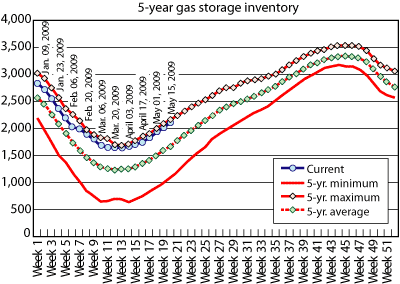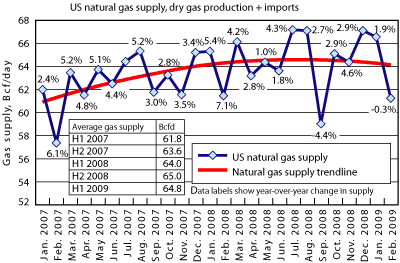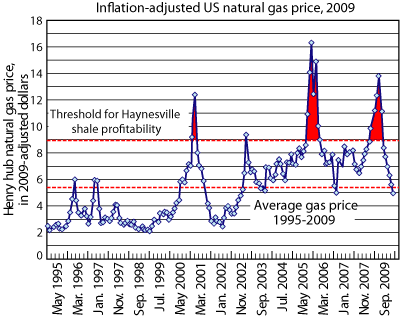What’s new in exploration
Vol. 230 No. 6 ARTHUR BERMAN, CONTRIBUTING EDITOR BERMANAE@GMAIL.COM A long recovery for gas prices: Revisiting the Haynesville Shale Natural gas prices increased 39% from a 61/2-year low of $3.19/MMBtu on April 27, 2009, to $4.42 on May
A long recovery for gas prices: Revisiting the Haynesville Shale Natural gas prices increased 39% from a 61⁄2-year low of $3.19/MMBtu on April 27, 2009, to $4.42 on May 13. Some think that the worst of the price collapse that began in July 2008 is over and that gas prices will return to normal. I do not believe that is the case, although I hope I am wrong. Chesapeake Energy proclaimed in a recent investor presentation that “the fix is under way,” and that natural gas prices will soon return to $7−8/Mcf. Chesapeake and other companies make the case that prices will rebound because of the drastic decrease in drilling. The gas-directed rig count has fallen from 1,606 to 728 since September 2008 and, because about 1,100 rigs are needed to maintain supply, we are creating a deficit that should cause the price to rise. The argument is logical and may prove true in the long term, but it is difficult to support near-term based on current events. During the same 2 1⁄2-week period of rising prices, working gas in storage has been 23% above the 5-year (2004−2008) average, indicating that supply is strong and/or demand is weak. Gas storage is what drives traders, and until storage levels decrease to 5-year averages or lower, I doubt that there can be a sustained price increase. The recent rally is probably related to rising crude oil price, a weaker US dollar and short-selling of gas futures contracts rather than a change in market fundamentals. At this writing, gas prices have already lost 30% of their recent gain. US gas supply includes two external sources: pipeline imports from Canada and LNG cargoes from all over the world. Imports from Canada are down, but LNG deliveries are way up. April LNG imports averaged 2 Bcfd—double the amount in March according to Jeffries & Company.1 Pritchard Capital Partners expects LNG deliveries to average 3.5 Bcfd for 2009 and get as high as 5 Bcfd.1 Global liquefaction capacity has increased more than 5 Bcfd this year as several large projects came online. Also, LNG prices have decreased because of lower global demand, reduced tanker costs, and because contract prices are tied to a trailing index of crude oil and other commodity prices that have fallen. Oversupply of gas may continue for longer than some expect. Average US gas production increased from about 58 Bcfd during the first half of 2008 to almost 60 Bcfd in the fourth quarter of 2008. In addition, there are large volumes of gas available from wells that are not yet connected to sales because of limited pipeline capacity and low netback cost. The Rocky Mountain Express Pipeline will open considerable volumes of gas that have not been previously available (3.2 Bcfd by June 2009, and an additional 1.8 Bcfd in November), and the Mid-Continent Express Pipeline recently added 0.64 Bcfd of capacity. Also, in the Gulf of Mexico, Independence Hub, Thunderhorse and Tahiti platforms, as well as initial production at Perdido, will increase gas production in 2009–2010.
Reduced demand because of the global economic crisis may contribute to a prolonged slump. By February 2009, demand had fallen across all sectors, including electricity, commercial and residential gas users, off some 14.5 Bcfd (16%) compared to January, and 7.4 Bcfd (9%) compared to February 2008. While the gas-directed rig count is down, drilling activity is strong in the Haynesville Shale play, where high-volume initial production rates work at cross-purposes to offset the over-supply of gas. There are at least 75 horizontal wells that are currently drilling, completing or are shut in pending pipeline connection. This could increase Haynesville daily production to more than 300 MMcfd. I want to thank readers and operators for their willingness to share information with me in response to my April column on the Haynesville. There is no doubt that the Haynesville is different from other shale plays, mainly because it is overpressured (~0.85 psi/ft). Overpressure and corresponding microfracturing combined with high shale porosity result in average initial production rates of more than 12 MMcfd and per-well EURs as high as 9.0 Bcf. I now think that the Haynesville Shale reserve estimates I presented previously were too low. I have evaluated 43 horizontal wells with some production history, and 14 wells with initial production rates only.2 The most-likely average EUR for all operators is 3.6 Bcf per well within a probabilistic range of 2.8−3.6−4.4 Bcf/well (although RBC Capital projects an average of 2.5 Bcf EUR for all horizontal wells3). The average EUR for key operators in the play varies: Petrohawk Energy has higher average EURs (3.9−5.1−6.2 Bcf) while Chesapeake Energy’s EURs are lower (2.2−2.8−3.3 Bcf). The average for other operators is 2.8–3.7–4.5 Bcf/well. I have not changed my conclusion that the Haynesville Shale play is marginally commercial. Drilling and completion costs vary from $7.5 to $10.5 million per well. The marginal cost for operators to find and develop gas reserves is $7 to 8/Mcf, and current netback prices in the play are less than $3/Mcf. The threshold netback gas price for a better-than-average 5.5-Bcf well to break even is $7/Mcf at NPV10 (Bodell and Pittinger, in press). For companies that have favorable hedge positions, realized gas prices for 2009 will be as high as $6.50/Mcf and $6.00/Mcf for 2010. This means that the play is marginally commercial today for operators with favorable hedge positions, but not commercial based on cost and price fundamentals. While many believe that natural gas prices will increase to $7–$8/Mcf by the end of this year, I am more pessimistic. Increased LNG imports, expanded pipeline capacity and ongoing gas-directed drilling all contribute to strong gas supply, while the recession is reducing demand. Thus, prices may not increase until the second quarter of 2010. I am also skeptical that prices will recover beyond about $5.50/Mcf, the average inflation-adjusted gas price since 1995. Shale plays have increased the marginal cost of production by about $2/Mcf, and I doubt that the market will reward that inefficiency. It seems more likely that LNG and conventional gas will play an increasingly important role in future US gas supply because of cost.
1 Platt’s Inside FERC’s Gas Market Report, May 1, 2009
|
||||||||
- Prices and governmental policies combine to stymie Canadian upstream growth (February 2024)
- U.S. producing gas wells increase despite low prices (February 2024)
- U.S. drilling: More of the same expected (February 2024)
- U.S. oil and natural gas production hits record highs (February 2024)
- Quantum computing and subsurface prediction (January 2024)
- U.S. upstream muddles along, with an eye toward 2024 (September 2023)







